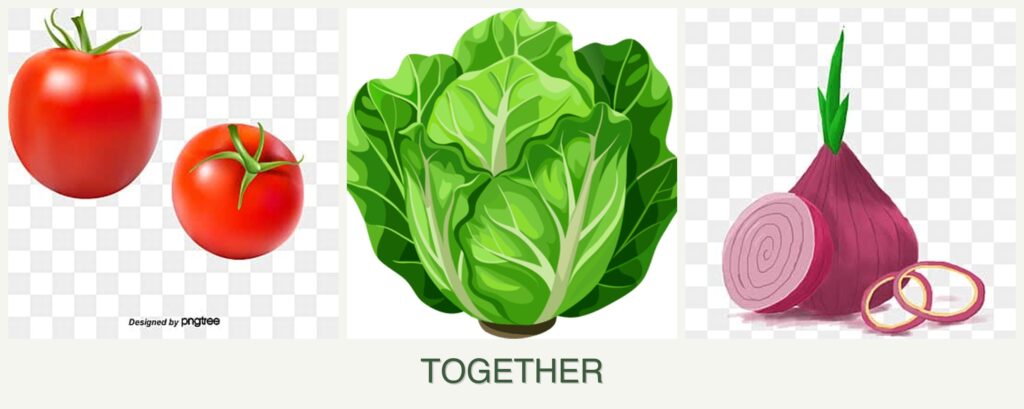
Can you plant tomatoes, lettuce and onions together?
Can You Plant Tomatoes, Lettuce, and Onions Together?
Companion planting is a popular gardening technique that involves growing different plants together to enhance growth, deter pests, and maximize space. Tomato, lettuce, and onion are commonly grown vegetables, but can they thrive together? In this guide, you’ll learn about their compatibility, benefits, and challenges, and discover tips for successful planting.
Compatibility Analysis
Yes, you can plant tomatoes, lettuce, and onions together. These plants complement each other well due to their differing growth habits and nutrient requirements. Tomatoes grow tall and provide shade, which benefits lettuce, a cool-season crop that prefers less direct sunlight. Onions, with their pungent odor, can deter pests that might otherwise target tomatoes and lettuce.
Key Factors:
- Growth Requirements: Tomatoes need full sun, while lettuce prefers partial shade, which tomatoes can provide. Onions can adapt to both conditions.
- Pest Control: Onions repel pests like aphids that are common to tomatoes and lettuce.
- Nutrient Needs: Tomatoes are heavy feeders, requiring rich soil, while onions and lettuce have moderate nutrient needs, making them compatible in a well-fertilized garden.
- Spacing: Proper spacing allows each plant to thrive without competing for resources.
Growing Requirements Comparison Table
| Plant | Sunlight Needs | Water Requirements | Soil pH | Soil Type | Hardiness Zones | Spacing | Growth Habit |
|---|---|---|---|---|---|---|---|
| Tomato | Full sun | Moderate | 6.0–6.8 | Loamy, well-drained | 3-10 | 18-24 inches | Tall, bushy |
| Lettuce | Partial shade | High | 6.0–7.0 | Moist, fertile | 4-9 | 6-12 inches | Low, leafy |
| Onion | Full sun | Moderate | 6.0–7.0 | Sandy, well-drained | 3-9 | 4-6 inches | Low, bulbous |
Benefits of Planting Together
Planting tomatoes, lettuce, and onions together offers several advantages:
- Pest Repellent Properties: Onions deter pests, reducing the need for chemical pesticides.
- Improved Flavor or Growth: The shade from tomatoes can prevent lettuce from bolting, enhancing flavor.
- Space Efficiency: Layered planting uses vertical and horizontal space efficiently.
- Soil Health Benefits: Diverse root systems can improve soil structure and nutrient uptake.
- Pollinator Attraction: Tomato flowers attract pollinators, benefiting the garden ecosystem.
Potential Challenges
While these plants can coexist, there are challenges to consider:
- Competition for Resources: Ensure adequate soil nutrients and water to prevent competition.
- Different Watering Needs: Lettuce requires more water; consider drip irrigation for consistency.
- Disease Susceptibility: Monitor for fungal diseases, especially in humid conditions.
- Harvesting Considerations: Stagger planting times to manage harvest overlap.
- Practical Solutions: Use mulch to retain moisture and reduce weeds; rotate crops annually to prevent soil depletion.
Planting Tips & Best Practices
- Optimal Spacing: Maintain recommended spacing to ensure airflow and reduce disease risk.
- When to Plant: Start tomatoes indoors 6-8 weeks before the last frost; direct sow lettuce and onions after frost danger has passed.
- Container vs. Garden Bed: Use containers for flexibility; ensure they have drainage and are large enough for root growth.
- Soil Preparation Tips: Amend soil with compost to improve fertility and drainage.
- Companion Plants: Basil and marigolds also pair well with tomatoes, lettuce, and onions, offering additional pest control and flavor enhancement.
FAQ Section
-
Can you plant tomatoes and lettuce in the same pot?
Yes, but ensure the pot is large enough for both root systems and has good drainage. -
How far apart should tomatoes and onions be planted?
Space tomatoes 18-24 inches apart and onions 4-6 inches apart to prevent competition. -
Do tomatoes and lettuce need the same amount of water?
No, lettuce needs more frequent watering, especially in hot weather. -
What should not be planted with tomatoes?
Avoid planting tomatoes with brassicas (e.g., cabbage) and fennel, which can inhibit growth. -
Will onions affect the taste of tomatoes?
No, onions will not alter the flavor of tomatoes when grown together. -
When is the best time to plant tomatoes, lettuce, and onions together?
Plant after the last frost date in your area, ensuring soil temperatures are warm enough for tomatoes.
By understanding the compatibility and requirements of tomatoes, lettuce, and onions, you can create a thriving companion planting setup that maximizes yield and minimizes pest issues. Happy gardening!



Leave a Reply